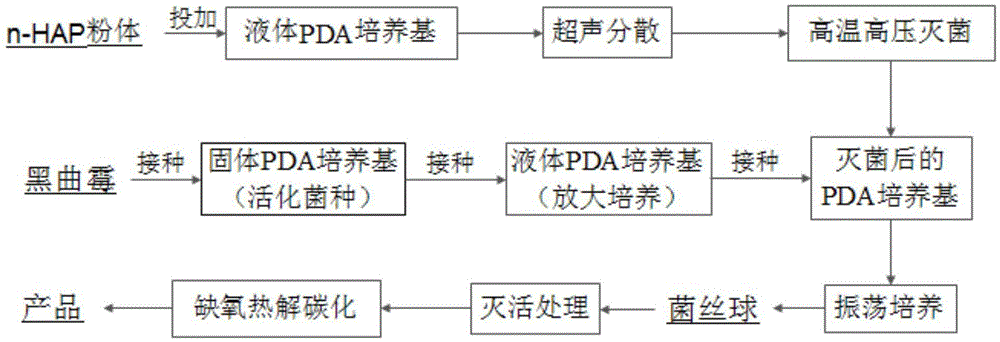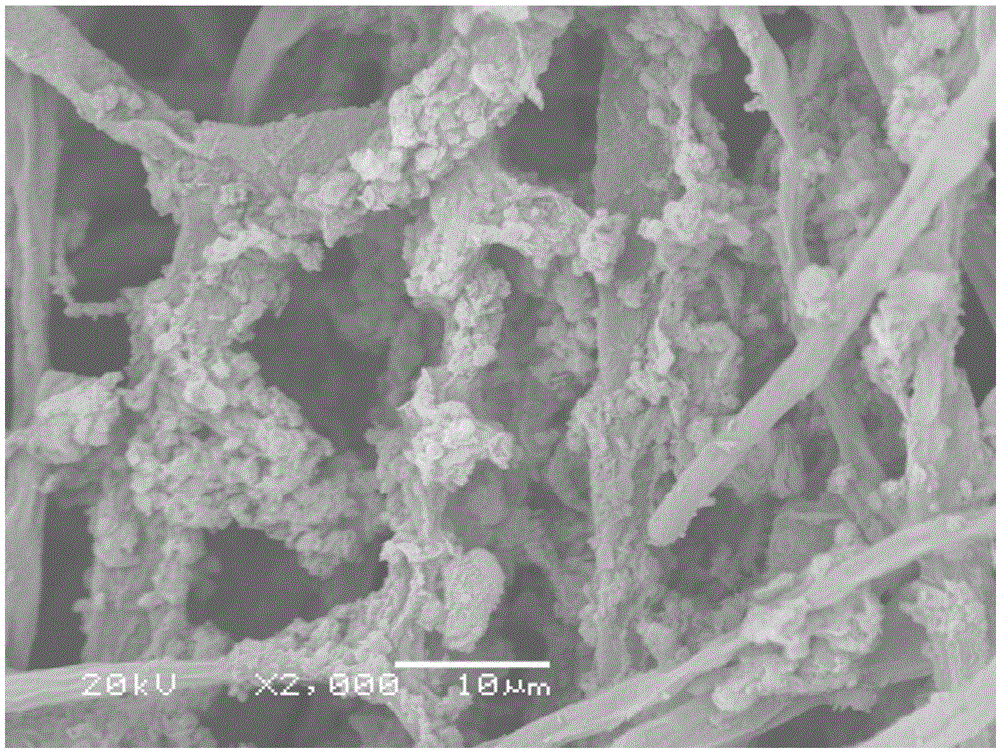Phosphorus-based biochar material, and preparation and application thereof
A biochar and phosphorus-based technology, applied in the restoration of polluted soil, etc., can solve the problems of easy loss and difficult quantification of n-HAP, and achieve the effect of clean and sustainable process, convenient large-scale production, and high reactivity
- Summary
- Abstract
- Description
- Claims
- Application Information
AI Technical Summary
Problems solved by technology
Method used
Image
Examples
Embodiment 1
[0038] Prepare the phosphorus-based biochar material for repairing cadmium-contaminated soil of the present invention:
[0039] (1) Use PDA medium to activate and expand the cultivation of Aspergillus niger (Aspergillus niger), purchased from China Center for Type Culture Collection, strain number CCTCCAF91006;
[0040] (2) Add 1.0 g of hydroxyapatite nanoparticles (particle size97%) into 200mL of liquid PDA medium, and disperse for 2 hours with ultrasonic waves with a power of 100 watts;
[0041] (3) Put the PDA medium containing nano-hydroxyapatite into a high-temperature and high-pressure sterilizer, set at 115° C., and sterilize for 25 minutes. After high-temperature and high-pressure sterilization, the culture medium was transferred to an ultra-clean aseptic operating table, and sterilized with an ultraviolet lamp for 60 minutes;
[0042] (4) In the ultra-clean aseptic operating table, inoculate the activated mycelium in step (1) into the sterilized medium of step (3), t...
Embodiment 2
[0049] The soil was taken from low-pollution paddy soil around a lead-zinc tailings pond. The soil to be tested was air-dried after removing the gravel and broken roots, mixed in quarters, and crushed through a 18-mesh nylon sieve. The pH of the soil is 6.58, which is slightly acidic. The available Cd content in the soil is 7.01mg / kg.
[0050] Add 0.2g of the phosphorus-based biochar material in Example 1 (the amount of n-HAP contained is equal to the amount of pure n-HAP weighed) and pure n-HAP into 5.0g of low-pollution soil, mix well, add 10mL After 7 days of fixation, 25mL DTPA was used to extract the available state of cadmium in the soil. After testing, the available content of cadmium in low-pollution soil before and after treatment with phosphorus-based biochar materials or pure n-HAP is shown in Table 1 below.
[0051] Table 1 Available Cd content in low-polluted soil before and after treatment
[0052]
Embodiment 3
[0054] The soil was taken from moderately polluted paddy soil around a lead-zinc tailings pond. The soil to be tested was air-dried after removing the gravel and broken roots, mixed in quarters, and crushed through a 18-mesh nylon sieve. The pH of the soil is 6.52, which is slightly acidic. The available Cd content in the soil is 36.8mg / kg.
[0055] Add 0.2g of the phosphorus-based biochar material in Example 1 (the amount of n-HAP contained is equal to the amount of pure n-HAP weighed) and pure n-HAP into 5.0g of contaminated soil, mix well, add 10mL After 7 days of fixation, 25mL DTPA was used to extract the available state of cadmium in the soil. After testing, the available content of cadmium in medium-polluted soil before and after treatment with phosphorus-based biochar materials or pure n-HAP is shown in Table 2 below.
[0056] Available Cd content in contaminated soil before and after treatment in Table 2
[0057]
[0058]
PUM
 Login to View More
Login to View More Abstract
Description
Claims
Application Information
 Login to View More
Login to View More - R&D
- Intellectual Property
- Life Sciences
- Materials
- Tech Scout
- Unparalleled Data Quality
- Higher Quality Content
- 60% Fewer Hallucinations
Browse by: Latest US Patents, China's latest patents, Technical Efficacy Thesaurus, Application Domain, Technology Topic, Popular Technical Reports.
© 2025 PatSnap. All rights reserved.Legal|Privacy policy|Modern Slavery Act Transparency Statement|Sitemap|About US| Contact US: help@patsnap.com



